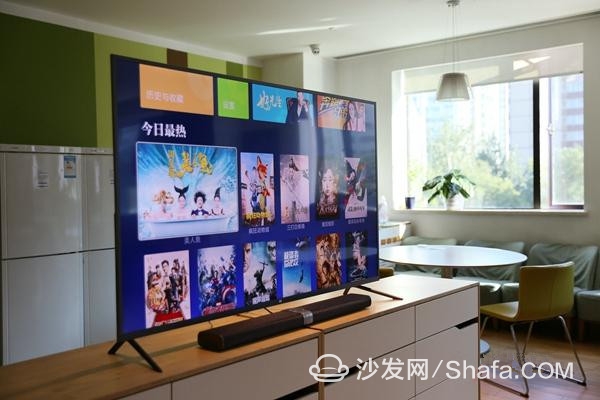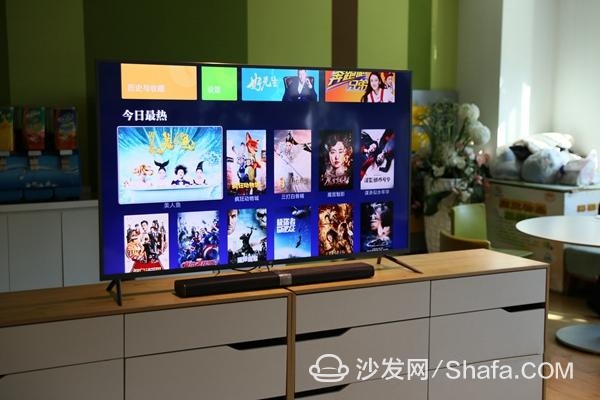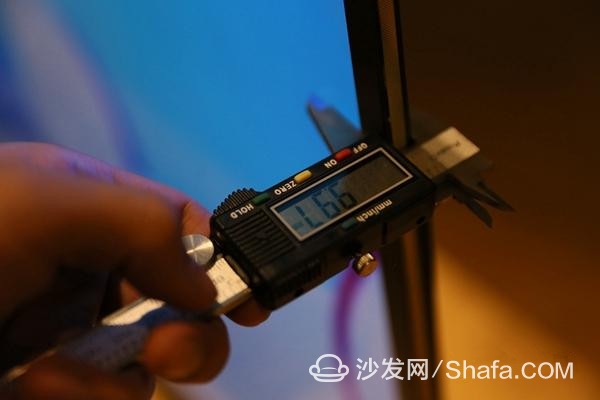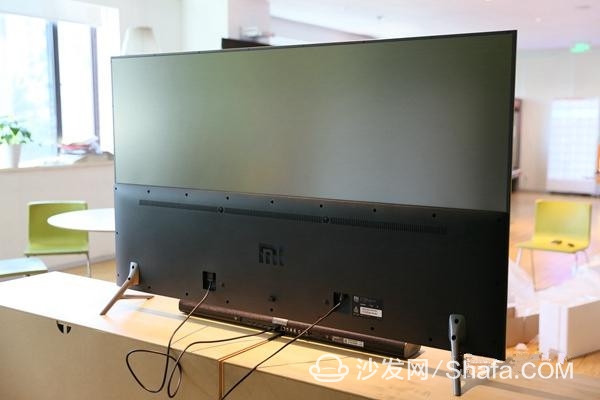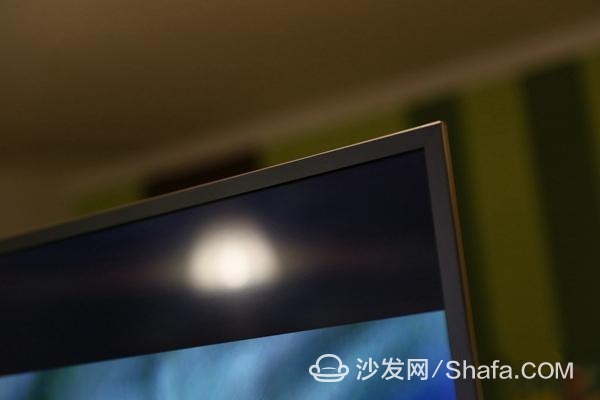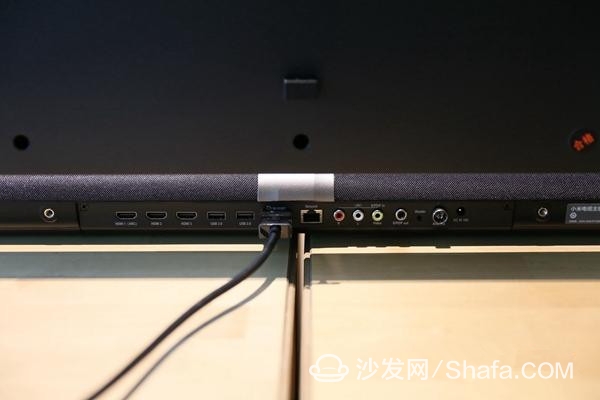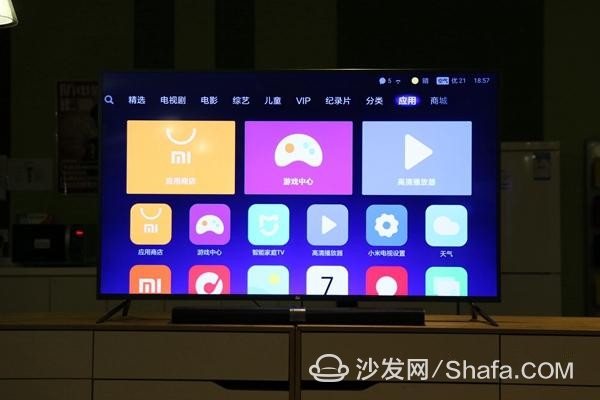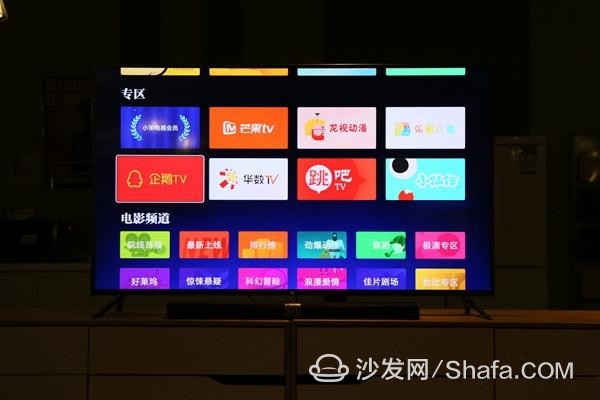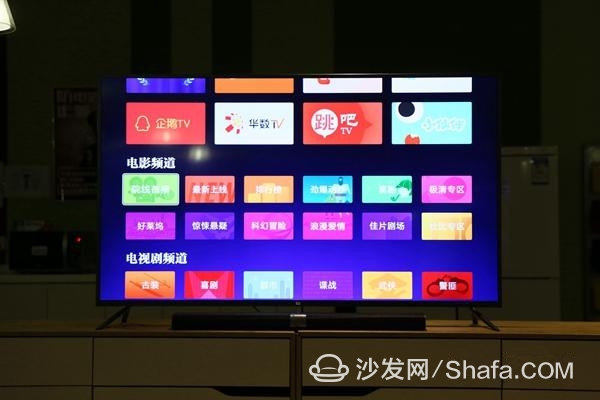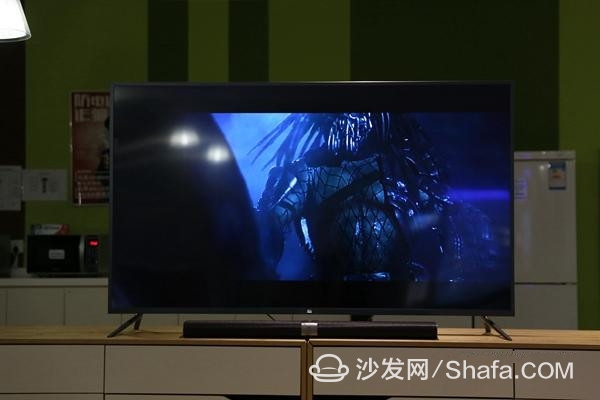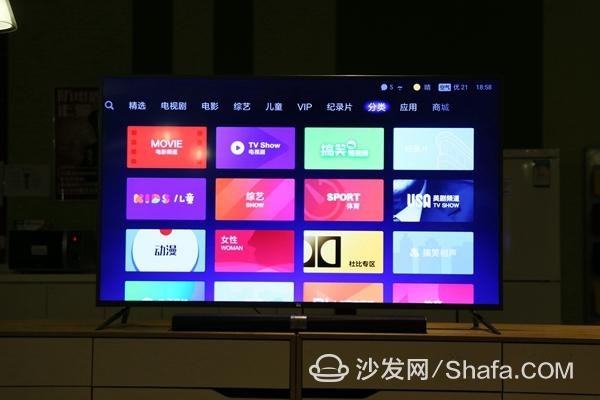The recent hot topic is Apple's new product launch conference in addition to Apple's paint and Samsung explosions. This time, Xiaomi not only unlocked the 5s, but also brought out innovative fingerprint recognition. At the same time, he also brought in new millet TV 3s. This millet is not limited to finding gimmicks on hardware, but it is a major selling point for system software upgrades. In the words of millet, it is called "artificial intelligence TV." Did millet 3s TVs that use the new system really bring significant improvements over the previous generation of products?
Still ultra-thin split design 9.9mm thickness
The 65-inch millet TV 3s continues the split design of the previous generation of millet TV 3, which comes standard with a SoundBar system, which is consistent with the previous generation of millet 3. The fuselage also uses ultra-narrow frame design, brushed texture and ultra-thin design process. Compared with TVs of the same kind and main frame with ultra-narrow borders, the bottom border of the 3D TV of the millet TV is also very narrow, and there is no protrusion. This is a major feature of Xiaomi TV in its appearance. Of course, this is not because of extraordinary technology, but also benefit from split design principles.
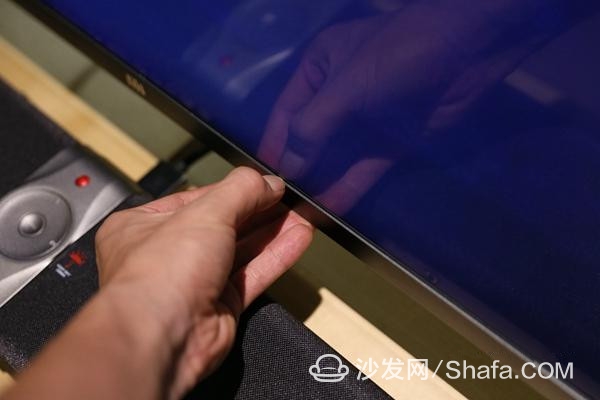
The whole TV set looks relatively simple, with the main body being black, and the gold metal frame structure is used on the side design. Both the visual effects and the overall strength of the TV are better. Because the size is relatively large, so I also focused on the screen at the seams of the central part of the upper and lower left and right sides, the result is done on the details of the millet 3s and the previous generation 3 to do exactly as there is no groove in this regard The point is more reassuring.
The base part of the TV, millet 3s continues the design of the previous generation of millet homes, without any changes, herringbone stands are very beautiful, and the weighing is also very good, the TV is very stable on the table. What's even more important is that the two brackets only need four screws to fix them easily, and it is not troublesome to install them.
The official claim that the thickness of the TV is only 9.9mm, of course, this is only the thinnest thickness. I also measured it with a vernier caliper, which is about 10mm. It is almost 9.9mm. It is basically the same as the official propaganda. Compared to the 12.9mm of the previous generation of millet 3, there is indeed a clear improvement in thickness. If it is a wall-mounted user, it should benefit from thickness.
The backplane part uses the split host routine, and the upper part is a simple metal shield. Interface Because the TV is originally a separate design, so the interface is mainly focused on the SoundBar above, the TV part only has the power interface and data connection. The advantage of this design is also to reduce the external retention line when the user hangs the wall.
Many people have doubts about split design, and I support it. Because you did not consider the situation of other external TV devices, once you external speakers, power amplifiers and other equipment, split design will undoubtedly be able to clear the line boundaries, allowing users to arrange the wiring in a hidden location.
The border design is a reflection of the details of a TV workmanship. The millet 3s frame uses a metal frame, and there is no reservation for workmanship in pursuit of cost performance. The detail processing is not weaker than any product on the market at present. Combining the price from 4999 yuan, you will find that it is really sincere.
The mainframe part is the SoundBar mentioned earlier. It not only integrates the audio part of the TV, but also puts the main processing elements inside. It has a built-in 64-bit Amlogic T966 processor and a fifth-generation image engine + HDR. . The audio part perfectly supports Dolby and DTS audio double decoding, so there will be some advantages in sound performance compared to other products that are not split design.
The details of the host part are also quite satisfactory, and the details of the layout of the keys have changed compared to the previous generation of products. The five control buttons are integrated in a circular structure so that the design is logically the same as the remote control of the millet TV. The power button is designed as a red bulge, and it is backlit. The advantage of this design is that the user can see the current state of the TV in the distance. In the case of some black screens or sleep, the TV will not be considered as Open, considered an optimal design.
In terms of interfaces, it is equipped with three standard HDMI interfaces, one USB3.0 interface, one USB2.0 interface, one MiPort interface, one Ethernet interface, one set of AV interfaces, and one S/PDIF terminal interface. An audio interface, an analog signal DTMB interface, and a separate power interface.
Improved user search efficiency
Although there has been little help for the PC system interface since the large color block system was adopted from Microsoft, TV manufacturers have discovered the advantages of this color block interactive interface. Since the introduction of television, television systems have adopted the horizontal sliding mode without exception. To put it bluntly, this color block design has been completely copied, and there is no innovation at all.
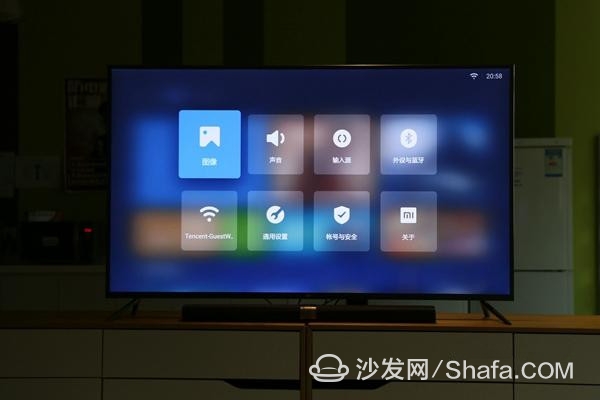
This millet brings a whole new system, which is one of the biggest features of this millet 3s. Xiaomi said that the current so-called smart TV is not "smart", not to watch online video called smart, only really understand your TV is called smart. Based on interface efficiency and understanding of intelligence. Xiaomi introduced the new TV intelligent system PatchWall puzzle wall system. With a stream called “Continuously Continuousâ€, magazine typesetting is used, not only because the font looks more delicate, but also the layout can be easily exchanged.
What's more, this Xiaomi system, through in-depth learning, claims to be able to recommend a variety of personalized movies to the audience for 365 days of the year to reach thousands of people.
Learning users' habits of pushing different content can be regarded as a kind of intelligent change, and the unlimited UI waterfall interface UI is worthy of recognition, at least, much stronger than those who do nothing.
In the design of the new PatchWall puzzle wall system, the first-level menu has become very diverse, providing a selection, TV drama, film, variety, children, VIP, documentary, classification, application, mall and other modules. Compared with the traditional integrated module, this change will help the user to see at a glance, saving some of the functions needed to find the trouble in the secondary menu.
Correspondingly, since it is an unlimited waterfall stream, the contents of the relevant channel are also directly placed below the channel page. After you press the remote control to the corresponding category, you can continue to page down. And the content is not indiscriminately stacked on the slide page, but further subdivided. You can always brush down indefinitely. Compared to previous content retrieval logic, it is clear that this design is more efficient and you can see as much as possible without using secondary or tertiary pages.
It is well known that using a search function on a television, if there is no speech input, then one letter or one letter input is very painful. So this new interface design also reduces the reliance on the search function to some extent. So no matter what the perspective, the new interface layout is more conducive to use.
In addition, this system can push different content on a daily basis according to the content you are interested in, and the degree of intelligence has indeed improved. However, this push change is not real-time, that is to say, what you see now does not immediately change back to the menu, you need to wait a day. Maintains relative consistency at the interface.
Good quality Tencent video settled content source
Millet TV 3s still uses the GITV broadcast control platform. Content sources, the new millet 3s added Tencent video content settled in, relying on Tencent strong video content support, millet TV 3s received all copyright content bonuses. As a result, Xiaomi TV 3s has assembled Tencent videos, iQIYI, Youku, and Mango TV on the content.
I tried to search for some movie titles in my mind that were randomly thought of as old movies and new movies. Some of them were perfectly searched for perfect play. Some of the new movies were only trailers. There is also a need for VIP members. Some less mainstream movies are not searched. This is just my random thought, indicating that the richness of the film source is still quite good.
In the specific viewing process, the fluency of the screen is very good even in the ultra-clear mode, and there is no trailing phenomenon. Just because you are relying on the network to load, the loading process at the beginning will slightly delay 2 seconds.
Color is the strength of this millet TV 3s, the panel uses a Samsung 4K panel, a resolution of 3840 × 2160, the overall color performance is balanced, moderate saturation. Using image analysis images, the line boundaries and the details of the color patches can also be clearly presented. The overall gray-scale rendering is relatively smooth, there is no obvious transition is not smooth or jumping conditions. The color ball is rich in performance and the transition is gentle. Also from the side, the viewing angle of the panel is very good, which is also one of the points worth talking about.
summary:
If Millet TV's 70-inch version is priced close to 10,000 yuan, which is far from being the "first TV for young people", then the new millet TV 3s has apparently returned to the right price-to-price ratio on the right path. . The 65-inch version starting at 4999 yuan will be very competitive in the mainstream TV market.
Looking at the products alone, Xiaomi TV 3s has achieved a profound transformation in the software while the hardware is fully upgraded. The new PatchWall puzzle wall system is, to a large extent, the application of Internet thinking to traditional hardware to make traditional hardware evolve again. illustration. Infinite brush + content intelligence analysis recommended form can undoubtedly greatly improve the efficiency of user search. It is worth mentioning that the product features highlighted at the press conference included 9 major aspects. The last one supported K song. I understood that it was a pure PPT connection. Once the microphone was purchased separately, the software needed to be downloaded separately. In fact, it has nothing to do with the TV product itself, and it is not reflected in this article. Overall, Xiaomi TV 3s is indeed a TV product worth recommending. Friends who are preparing to buy TV in the near future can consider it.
Smart TV/box information can focus on smart TV information network sofa butler (http://), China's influential TV box and smart TV website, providing information, communication, TV boxes, smart TVs, smart TV software, etc. Answering questions.
GPON Ethernet ONT
Ont, namely optical network equipment, is a product in the xpon network access solution.
Generally speaking, an ONT is an ONU, which is an optical network terminal used at the user end.
Strictly speaking, ONT should belong to part of ONU.
The difference between an ONT and an ONU is that an ONT is an optical network terminal and is directly located at the user end, while an ONU is an optical network unit, and there may be other networks, such as Ethernet, with the user.
The ONU can be connected to the gateway device of xDSL (adsl, vdsl) or Ethernet access port, and then connected to the network terminal.
Ethernet is a computer local area network technology. The IEEE 802.3 standard organized by the IEEE establishes the technical standard for Ethernet, which specifies the content of the physical layer wiring, electronic signals, and media access layer protocol. Ethernet is currently the most commonly used LAN technology, replacing other LAN technologies such as token ring, FDDI and ARCNET.
Ethernet is the most common computer network in the real world. There are two types of Ethernet: the first type is classic Ethernet, and the second type is switched Ethernet, which uses a device called a switch to connect different computers. Classic Ethernet is the original form of Ethernet, and its operating speed ranges from 3 to 10 Mbps. Switched Ethernet is a widely used Ethernet that can run at high speeds such as 100, 1000, and 10000 Mbps. NET, Gigabit Ethernet and 10 Gigabit Ethernet.
The standard topology of Ethernet is a bus topology, but the current Fast Ethernet (100BASE-T, 1000BASE-T standards) in order to reduce conflicts, maximize the network speed and use efficiency, and use switches for network connection and organization. In this way, the topology of the Ethernet becomes a star; but logically, the Ethernet still uses the bus topology and CSMA/CD (Carrier Sense Multiple Access/Collision Detection). Bus technology.
Ethernet realizes the idea of sending information from multiple nodes in the radio system on the network. Each node must obtain a cable or channel to transmit information. It is sometimes called Ether. (The name comes from the electromagnetic radiation medium-optical ether assumed by physicists in the 19th century. Later studies proved that optical ether does not exist.) Each node has a globally unique 48-bit address, which is the MAC address assigned to the network card by the manufacturer , To ensure that all nodes on the Ethernet can identify each other. Because Ethernet is so common, many manufacturers integrate Ethernet cards directly into computer motherboards.
Gpon 1Ge Onu,4Ge Onu,Gpon Ethernet Ont,Gpon Catv Ont
Shenzhen GL-COM Technology CO.,LTD. , https://www.szglcom.com
